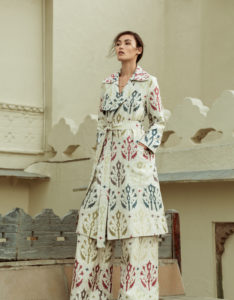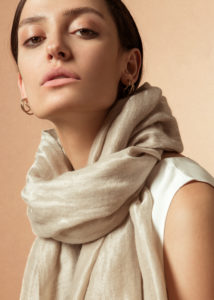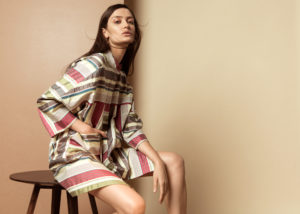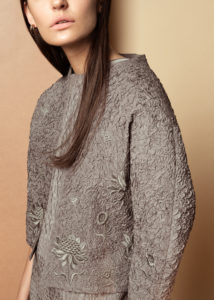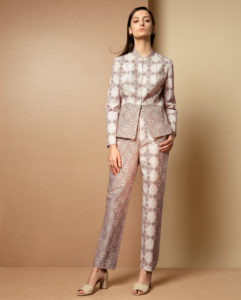The recently launched Indian luxury fashion brand, Varana, finds its first home in London’s Mayfair district. It promises to be India’s answer to Hermès, even as it stays rooted in the country’s rich craftsmanship and textiles.
Varana Store, Mayfair, London
They are quite clear that their DNA in Indian. But their ambition: to be India’s answer to Hermès, to occupy that uber-luxury space that no Indian brand has ever occupied.
Varana, a brand out of New Delhi, has, for one, opened an expansive upscale store in London’s historic Mayfair district. This six-month-old luxury brand wants to dispel the myth that Indian clothes are low-cost and badly tailored, or worse, all-bling. Dover Street is a snooty-nosed neighborhood speckled with brands such as Victoria Beckham, Jimmy Choo, Christian Louboutin, Aston Martin and Acne Studio, which puts Varana in good company.
It took Varana several years to zero in on the store and the location that they consider right for their kind of brand. “It hasn’t been easy to convince landlords that a totally new Indian brand can rake in the discerning crowd of Mayfair,” says Sujata Keshavan, a co-founder of the brand. The store they are in right now once housed the Alexander McQueen label. “We bid for so many properties over two years and we were turned down. It was a victory when we got this one.”
The store has a gallery-meets-spa vibe, with shelves made of rattan, the rails of brass.
Keshavan believes that “India has so much to offer the world which is unique and rare. We have rich and deep traditions of art, craft and design that go back several thousand years. No other country can match the extraordinary weaving, printing, dyeing and embroidery techniques of our textiles. Yet, we had no brand that showcased these amazing things to the world.”
Varana gets its name from the ancient city of Varanasi. The brand, says Keshavan, is a happy blend of the east and the west, but with price tags that parallel Hermès. A cashmere coat with brocade lining costs £2,500, while a hand-painted and embroidered pashmina shawl goes for £10,000.
Keshavan, incidentally, is considered a pioneer in the South Asian design industry, and was a founder at Ray+Keshavan, an influential design firm eventually acquired by British conglomerate WPP. Ravi Prasad, the second co-founder, was the President and CEO of personal care brand Himalaya, and is credited for moving the company from being a pharmaceutical manufacturer to a head-to-heel wellness brand. Between them, they are looking to create a global brand of the highest quality, but rooted in India’s craftsmanship and heritage.
Varana uses all the beautiful embroidery, weaves and textiles that most Indian designers use: Aari, Jamdani, Wood Block Printing, and Pashmina, but does it in a way that make their garments truly international. Keshavan adds, “India has incredible hand skills, and our artisans are extraordinary. It’s time we showcase that.”
Through its London store the brand sells apparel, furniture, home accents, carpets and stationery. It works with natural fibers like cotton, silk and linen, all woven in India. Their cashmere comes from Kashmir, and is used to make exquisite knits and coats. “Not many people know that India’s craftsmen are doing super quality work for some of the world’s biggest labels,” adds Prasad. “So far, Indian artisans have been working with Western designers.”
On Varana’s team are textile designers from India, Italy and Japan, as well as European pattern cutters. Their Autumn/Winter 2017 collection is inspired by the Taj Mahal, its stone-work, inlays and the Mughal aari embroidery technique. A Shah Jahan floral print found on a manuscript has been painstakingly embroidered on to jacquard, for instance.
Characterized by fine fabrics, clean lines and beautiful cuts, customized right from the making of the fabric to the styling of the garment, Varana emphasizes craftsmanship. In the first few months, their customer base has ranged from British aristocracy and Middle-Eastern clientele to many Chinese, Japanese and Korean buyers. “We’re not targeting first-time luxury buyers,” says Keshavan. “We’re already on a high — our items have travelled from Tasmania to Buenos Aires.”
The plan is also to get Varana into multi-brand outlets such as Harrods and Selfridges, and expand to Paris and New York over time, possibly through franchise stores. “It’s time we take stories from India to the world,” says Prasad.


